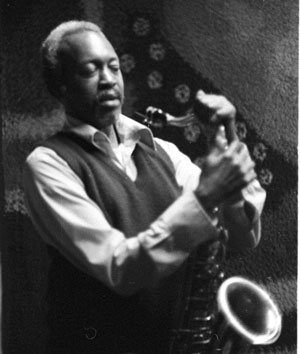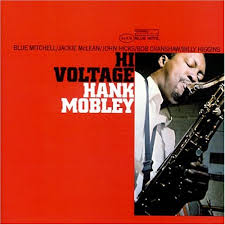No More Goodbyes – Hank Mobley
This gorgeous, wistful ballad is one of Hank Mobley's most intricate compositions. Our melody transcription shows how Hank played this song on the recording.
- Recording: Hank Mobley - Hi Voltage
- Recorded on: October 9, 1967
- Label: Blue Note (BLP 4273)
- Concert Key: F
- Vocal Range: , to
- Style: Ballad
- Tenor Sax - Hank Mobley
- Piano - John Hicks
- Bass - Bob Cranshaw
- Drums - Billy Higgins
0:00
0:00
Buy MP3
Purchase No More Goodbyes - Hank Mobley
Purchasing this song through our affiliate links with certain retailers provides jazzleadsheets.com with additional support to help keep us bringing you the best lead sheets available. Thank you!
Video
- Description
- Historical Notes
- Solos
- Piano Corner
- Bass Corner
- Drum Corner
- Guitar Corner
- Inside & Beyond
- Minus You
No More Goodbyes shows a very different side of Hank Mobley from most of his compositions, especially in the latter part of his career. This ballad has a wistful, plaintive and introspective sound despite being in a major key. This is achieved mainly by the melody never landing on the root of any major chord. Even at the end of the song, the last melody note is A, the 3rd in F major; B♮ in the melody in the last two measures suggests an A minor tonality though harmonized with Fmaj7(♯11). In addition several other melody notes are upper extensions of the chords—sharp 11ths or flat 9ths.
The changes are quite colorful, especially for a Hank Mobley song, with modulations to many key centers throughout. The A section visits A major and D♭ major—a cycle of major 3rds as in Giant Steps changes, made particularly elegant by tritone substitute approaches (for example B♭7 to Amaj7). The bridge starts with bass pedal figures using a double-time feel. There is a coda that repeats the last melody phrase three more times in a sequence—not really a "tag" as it is all over one chord; it's a particularly poetic and romantic ending.
Our lead sheet shows the basic melody. In addition we have a three-page melody transcription showing exactly how Hank plays this song on the recording. See the Solos tab for more details.
The changes are quite colorful, especially for a Hank Mobley song, with modulations to many key centers throughout. The A section visits A major and D♭ major—a cycle of major 3rds as in Giant Steps changes, made particularly elegant by tritone substitute approaches (for example B♭7 to Amaj7). The bridge starts with bass pedal figures using a double-time feel. There is a coda that repeats the last melody phrase three more times in a sequence—not really a "tag" as it is all over one chord; it's a particularly poetic and romantic ending.
Our lead sheet shows the basic melody. In addition we have a three-page melody transcription showing exactly how Hank plays this song on the recording. See the Solos tab for more details.
"Hi Voltage" was recorded at the legendary Van Gelder Studio in Englewood Cliffs.
For another Hank Mobley ballad, check out Madeline, which also has a melody transcription. Hank Mobley wrote a few ballads, mostly early in his career; No More Goodbyes was his last recorded original ballad.
"Hi Voltage" was pianist John Hicks' first recording for Blue Note and his first recording at the Van Gelder Studio. Eight days later, Hicks was back at Van Gelder's for a session with saxophonist George Braith for the Prestige label, which remains unissued. John Hicks' very last recording was also at Van Gelder's: his own 2006 HighNote album "Sweet Love Of Mine."
For another Hank Mobley ballad, check out Madeline, which also has a melody transcription. Hank Mobley wrote a few ballads, mostly early in his career; No More Goodbyes was his last recorded original ballad.
"Hi Voltage" was pianist John Hicks' first recording for Blue Note and his first recording at the Van Gelder Studio. Eight days later, Hicks was back at Van Gelder's for a session with saxophonist George Braith for the Prestige label, which remains unissued. John Hicks' very last recording was also at Van Gelder's: his own 2006 HighNote album "Sweet Love Of Mine."
This melody transcription includes everything Hank played on the track. Hank plays the head in, then after two A sections of piano solo he comes back to take the bridge out. Though he mostly improvises on the C section of the in head and the out bridge, he usually implies the basic contour of the melody phrases. After holding out the last note of the coda, Hank repeats the last melody phrase twice more, fading away at the end. Our transcription has detailed articulation markings for an in-depth look at Hank's ballad style.
Related Songs
Email Send No More Goodbyes to a friend
Send this page to a friend via email. Add your name or email in the first field. In the second, add one or more email addresses, separated by a comma.

Hank Mobley
July 7, 1930 – May 30, 1986
Hank Mobley is one of the most acclaimed tenor saxophonists in modern jazz history. He is recognized by musicians and critics alike as one of the most important and eloquent jazz instrumentalists of all time. He recorded well over 100 of his own original compositions and left an indelible mark on the post-bop jazz scene. Read more...
There was a problem.
...

